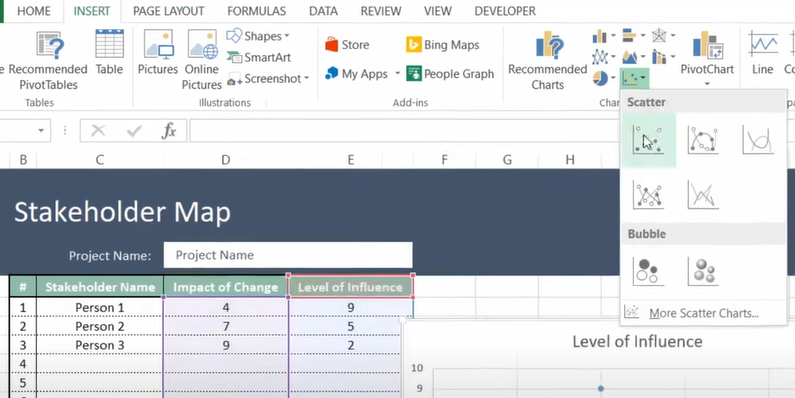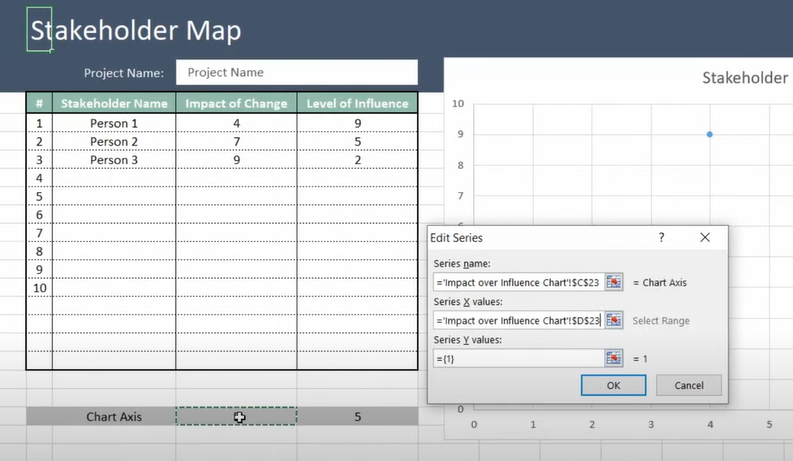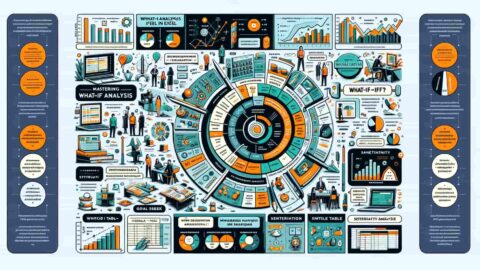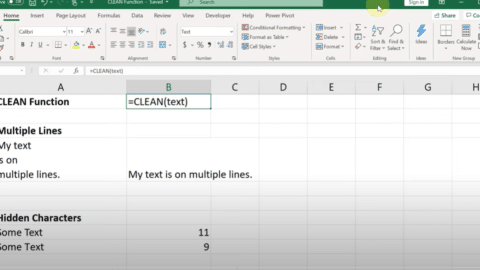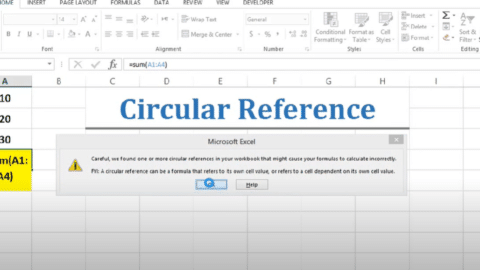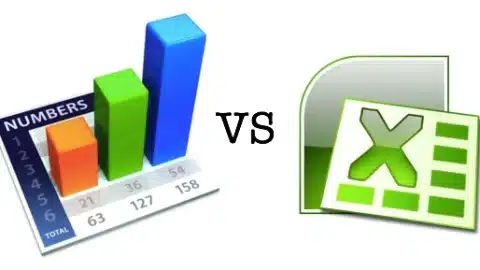How to Make a Stakeholder Map in Excel: 10 Stakeholder Map Templates
Stakeholder analysis example provides insight into how this process can be executed effectively. By identifying key stakeholders, analyzing their interests, and assessing their level of influence, project teams can develop strategies to engage and manage them throughout the project lifecycle.
Table of Contents
One of the fundamental tools used in stakeholder analysis is the Power Interest Grid template. Also, this template categorizes stakeholders based on their level of power and interest in the project, enabling project managers to prioritize their engagement efforts. Additionally, the Stakeholder mapping template is another valuable tool that visually represents stakeholder relationships and their respective attributes, facilitating clearer communication and decision-making.
Read the article to download Free Stakeholder Mapping Templates!
Understanding Stakeholder Mapping
Stakeholder mapping, or “Stakeholder map nedir” as known in Turkish, is a process used to identify, analyze, and prioritize stakeholders based on their importance and influence on a project. Also, this technique enables project teams to gain insights into the needs, expectations, and concerns of various stakeholders, allowing for more informed decision-making and effective communication strategies.
The Power interest grid is a commonly used framework in stakeholder mapping (Stakeholder Map in Excel). Also, it classifies stakeholders into four quadrants based on their level of power and interest in the project: high power-high interest, high power-low interest, low power-high interest, and low power-low interest. By understanding where stakeholders fall within this grid, project teams can tailor their engagement strategies accordingly.
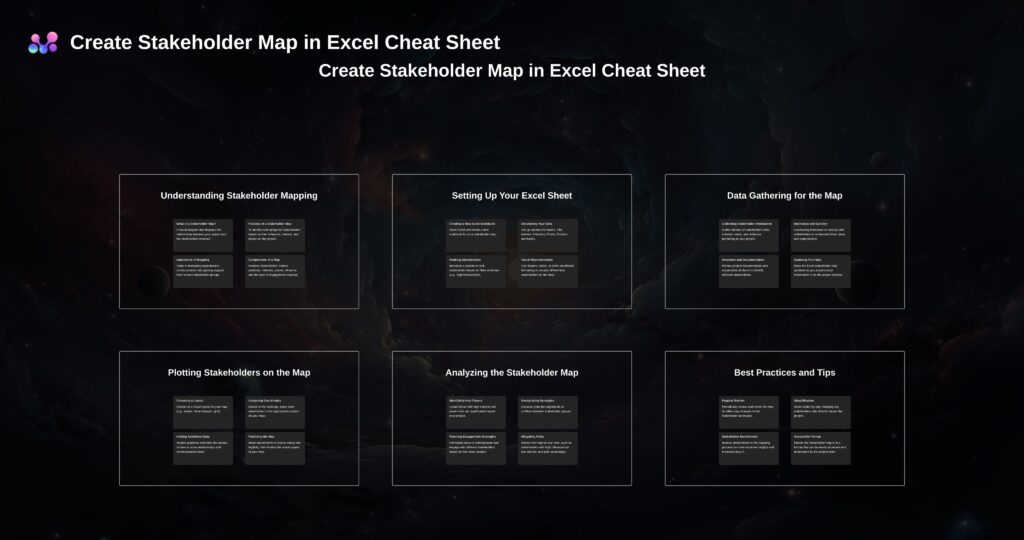
creating a stakeholder map in excel
Stakeholder Mapping Benefits
Stakeholder mapping offers a multitude of advantages, crucial for streamlined project management and organizational success. Firstly, it aids in prioritizing resources and efforts by identifying key stakeholders and their respective levels of influence or interest. Consequently, resources can be allocated efficiently, maximizing impact while minimizing waste. Additionally, by delineating stakeholders and their interests, effective communication channels can be established, fostering collaboration and ensuring that pertinent information reaches the right parties promptly.
Moreover, stakeholder mapping serves as a proactive measure to mitigate conflicts. By understanding the concerns and objectives of various stakeholders, preemptive strategies can be devised to address potential areas of contention before they escalate. Also, this not only preserves organizational harmony but also enhances stakeholder satisfaction by demonstrating a proactive approach to addressing their needs and concerns.
Furthermore, the process of stakeholder mapping (Stakeholder Map in Excel) contributes to better decision-making by providing a comprehensive understanding of diverse perspectives and interests. Also, considering stakeholders’ viewpoints allows for more informed and balanced decision-making, increasing the likelihood of achieving consensus and buy-in from all relevant parties. Consequently, decisions are more likely to align with overarching organizational goals and objectives, driving greater efficiency and effectiveness in implementation.
In essence, stakeholder mapping acts as a navigational tool, guiding organizations through complex landscapes of interests, influences, and relationships. By fostering transparency, collaboration, and understanding, it serves as a cornerstone for successful project execution and organizational advancement.
Mind Map Stakeholder Map in Excel
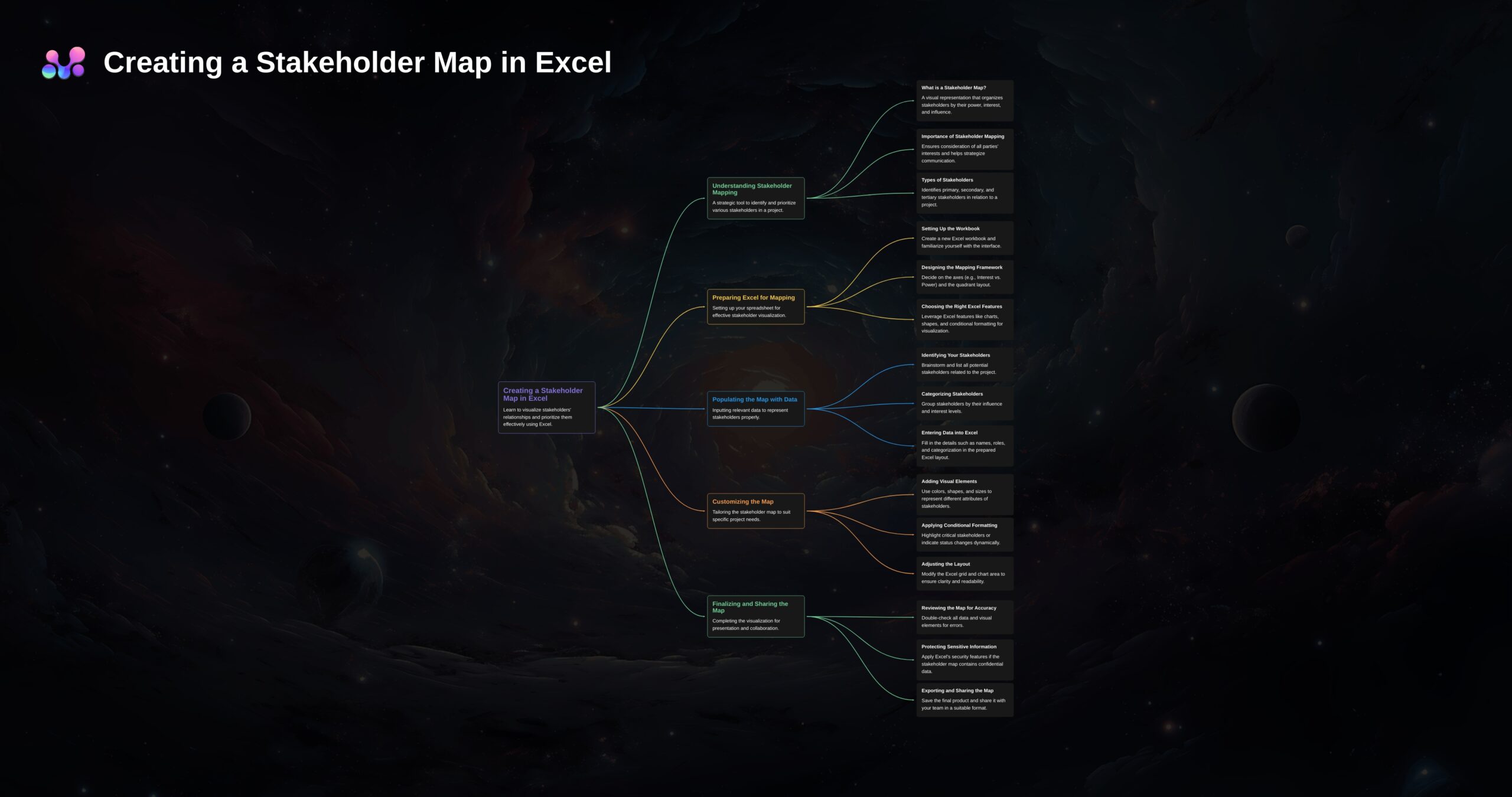
Mind Map Stakeholder Map in Excel
What is Stakeholder Analysis?
Stakeholder analysis is a systematic process of identifying and understanding stakeholders involved in a project, assessing their interests, influence, and potential impact on the project’s outcomes. Also, by conducting a stakeholder analysis, project managers can gain valuable insights into stakeholders’ needs, expectations, concerns, and potential risks they may pose to the project.
Importance of Stakeholder Analysis
Stakeholder analysis serves several crucial purposes in project management:
- Identifying Key Players: It helps in identifying all individuals or groups who can affect or be affected by the project.
- Understanding Stakeholder Needs: By analyzing stakeholders’ interests and expectations, project managers can tailor project strategies to meet their requirements effectively.
- Managing Expectations: It enables project managers to manage stakeholders’ expectations, thereby minimizing conflicts and ensuring smoother project execution.
- Mitigating Risks: Identifying potential risks associated with stakeholders allows project managers to proactively address issues and minimize negative impacts on the project.
Utilizing a Stakeholder Analysis Template in Excel
Excel provides a versatile platform for conducting stakeholder analysis due to its flexibility and customizable features. Also, Stakeholder Analysis Template in Excel typically includes the following components:
- Stakeholder Identification: Create a comprehensive list of all stakeholders involved in the project, including their names, roles, and affiliations.
- Stakeholder Assessment: Evaluate stakeholders based on their level of influence, interest, support, and potential impact on the project. This can be done using numerical scales or qualitative assessments.
- Stakeholder Mapping: Visualize stakeholder relationships and power dynamics using charts or graphs to identify key influencers and decision-makers.
- Strategy Formulation: Develop strategies for engaging with stakeholders based on their interests and influence, including communication plans, engagement strategies, and conflict resolution mechanisms.
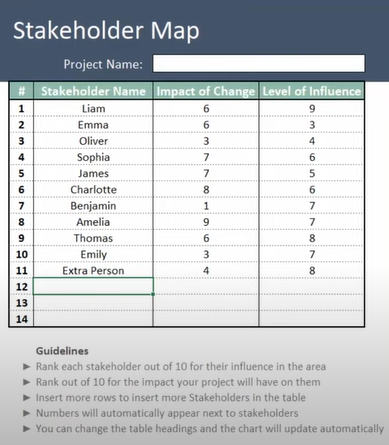
how to make stakeholder map in excel step 1
Tips for Effective Stakeholder Analysis Using Excel Template
To maximize the effectiveness of your stakeholder analysis using an Excel template, consider the following tips:
- Customize the Template: Tailor the template to suit the specific needs and requirements of your project. Also, customize fields, labels, and criteria based on the nature of stakeholders and project objectives.
- Regular Updates: Keep the stakeholder analysis template up-to-date by regularly reviewing and revising stakeholder information as the project progresses. Also, new stakeholders may emerge, and existing stakeholders’ interests may evolve over time.
- Collaborative Approach: Also, involve relevant team members and stakeholders in the stakeholder analysis process to ensure comprehensive insights and foster stakeholder buy-in.
- Data Validation: Implement data validation measures to ensure the accuracy and integrity of stakeholder information entered into the Excel template.
- Visual Representation: Utilize Excel’s charting and graphing tools to visually represent stakeholder data, making it easier to identify patterns, trends, and relationships.
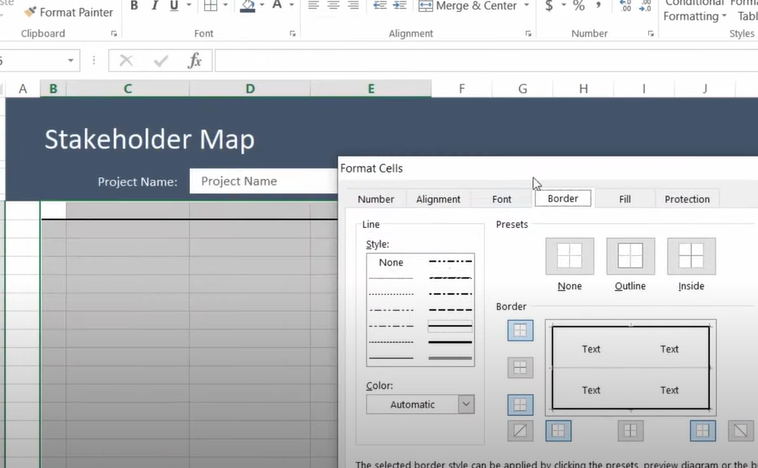
How to Make a Stakeholder Map in Excel step 2
Importance of Stakeholder Mapping
Stakeholder mapping plays a crucial role in change management, as it helps project teams anticipate potential challenges, mitigate risks, and build support for proposed changes. Also, by identifying key stakeholders and understanding their perspectives, project managers can proactively address concerns and foster collaboration, ultimately increasing the likelihood of project success.
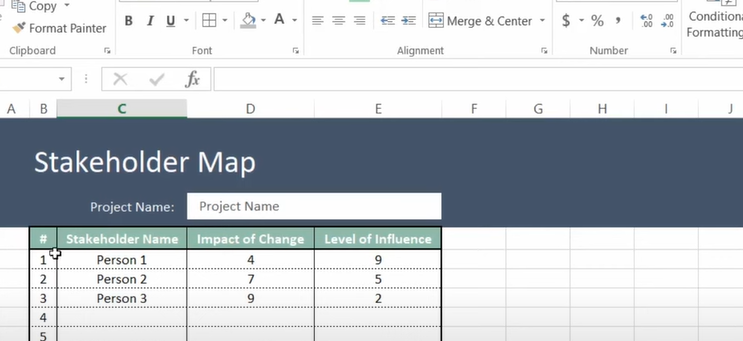
How to Make a Stakeholder Map in Excel step 3
In addition to its impact on project outcomes, stakeholder mapping also contributes to organizational effectiveness by promoting transparency, accountability, and stakeholder engagement. Also, by involving stakeholders in the decision-making process and actively seeking their input, organizations can build trust and foster a culture of collaboration and innovation.
Hello, I’m Cansu, a professional dedicated to creating Excel tutorials, specifically catering to the needs of B2B professionals. With a passion for data analysis and a deep understanding of Microsoft Excel, I have built a reputation for providing comprehensive and user-friendly tutorials that empower businesses to harness the full potential of this powerful software.
I have always been fascinated by the intricate world of numbers and the ability of Excel to transform raw data into meaningful insights. Throughout my career, I have honed my data manipulation, visualization, and automation skills, enabling me to streamline complex processes and drive efficiency in various industries.
As a B2B specialist, I recognize the unique challenges that professionals face when managing and analyzing large volumes of data. With this understanding, I create tutorials tailored to businesses’ specific needs, offering practical solutions to enhance productivity, improve decision-making, and optimize workflows.
My tutorials cover various topics, including advanced formulas and functions, data modeling, pivot tables, macros, and data visualization techniques. I strive to explain complex concepts in a clear and accessible manner, ensuring that even those with limited Excel experience can grasp the concepts and apply them effectively in their work.
In addition to my tutorial work, I actively engage with the Excel community through workshops, webinars, and online forums. I believe in the power of knowledge sharing and collaborative learning, and I am committed to helping professionals unlock their full potential by mastering Excel.
With a strong track record of success and a growing community of satisfied learners, I continue to expand my repertoire of Excel tutorials, keeping up with the latest advancements and features in the software. I aim to empower businesses with the skills and tools they need to thrive in today’s data-driven world.
Suppose you are a B2B professional looking to enhance your Excel skills or a business seeking to improve data management practices. In that case, I invite you to join me on this journey of exploration and mastery. Let’s unlock the true potential of Excel together!
https://www.linkedin.com/in/cansuaydinim/


